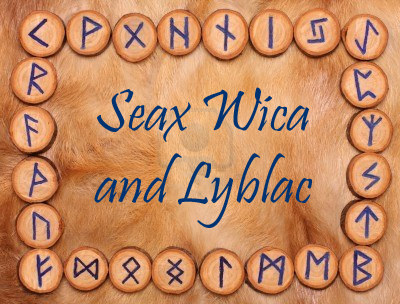 Seax
Wica And Lyblac
Seax
Wica And Lyblac
 Seax
Wica And Lyblac
Seax
Wica And Lyblac
The Anglo-Saxon word galdor (Old Norse galdr) refers to a kind of magical charm that is chanted or sung. Among the verse forms Snorri Sturluson lists in the section of his Prose Edda called Hattatal, he includes an example of galdralag --the Galdr metre, so it's possible that galdr charms had a particular rhythmic structure in Old Norse.
Little information concerning the use of galdor has come down to us, although they seem to have been a well known form of magic in heathen times. The Old Norse terms galdrakona (galdr-woman) and galdramaðr (galdr-man), and the Anglo-Saxon term galdra, were used to designate a witch or sorcerer. The Anglo-Saxon Journey Charm, for personal protection while travelling, includes the words: Sygegealdor ic begale, 'a victory galdor I sing'. The noble narrator of the Anglo-Saxon Riming Poem looks back to days when he was happy and prosperous and reminisces: ahte ic eadorstl, galdorwordum gol 'I sat on the high seat, sang galdor- words'. The Icelandic Grettis Saga describes how an old woman called Thurid brought about the downfall of her enemy, the hero Grettir. She carved runes into the flat side of a tree stump, reddened them with her blood, and 'kvað yfir galdra', recited galdors over them.
Though galdor chants could clearly be used for constructive as well as destructive magical purposes, galdor users were vilified in Christian times along with those who practised other heathen forms of magic. In the preface to his law code, King Alfred the Great states that women who are accustomed to harbour gealdor-cræftigan (those skilled in galdor) should not be permitted to live.
Although the Anglo-Saxon and Old Norse literary evidence suggests that galdor charms took the form of poetic verse, modern practitioners of rune-magic often use the term 'galdr' to refer to the act of chanting the names of runes (or the sounds represented by runic characters). Such chanting may be done during a ritual to invoke the energy of the rune, or over an object when imbuing it with runic energy. The concept of galdor as rune sound was popularised by Edred Thorsson, whose 1984 occult-category offering Futhark: A Handbook of Rune Magic states: "The galdr is the root form of incantation (or if you will, mantra), which is the vibratory embodiment of the rune." Other authors seem to have adopted this terminology. In Teutonic Magic (1994) Kveldulf Gundarsson defines 'Galdr-Magic' as 'runic magic, ritual magic (as contrasted with the shamanic seidhr-magic)' and 'Galdr-Sound' as 'Mantra consisting of the actual sound associated with a rune'.